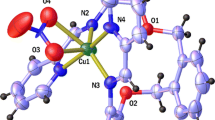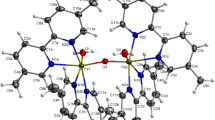Abstract
A series of related 3-hydroxypyridin-4-one hexadentate ligands have been synthesized. These chelators were found to possess a high affinity for iron(III), with a pFe value of about 30. As iron is a critical element to the survival of bacteria, these chelators were predicted to inhibit the growth of bacteria by disrupting bacterial iron absorption. Indeed, they were demonstrated to possess appreciable inhibitory activity against both Gram-positive and Gram-negative bacteria, and therefore, they have potential as antimicrobial agents. 1c and 1g were found to be particularly effective against Gram-negative species.
Graphical Abstract
A series of related 3-hydroxypyridin-4-one hexadentate ligands have been synthesized. These chelators were found to possess a high affinity for iron(III), and exhibit appreciable inhibitory activity against both Gram-positive and Gram-negative bacteria, and therefore, they have potential as antimicrobial agents.





Similar content being viewed by others
References
Alderighi L, Gans P, Ienco A, Peters D, Sabatini A, Vacca A (1999) Hyperquad simulation and speciation (HySS): a utility program for the investigation of equilibria involving soluble and partially soluble species. Coord Chem Rev 184:311–318
Anderson WV (1980) Iron chelation in the treatment of Cooley’s anemia. In: Martell AE (ed) Inorganic chemistry in biology and medicine. ACS Symp Ser 140, American Chemical Society, Washington, DC, p 251
Barry AL (1976) In: Kimpton H (ed) The antimicrobic susceptibility test: principles and practices. Lea & Febiger, Philadelphia, pp 76–91
Bergan T, Klaveness J, Aasen AJ (2001) Chelating agents. Chemotherapy 47:10–14
Chew P, Joelker LW, Tanaka TG (1985) In vitro growth inhibition of mastitis causing bacteria by phenolics and metal chelators. J Dairy Sci 68:3037–3046
Dobbin PS, Hider RC, Hall AD, Taylor PD, Sarpong P, Porter JB, Xiao G, vanderHelm D (1993) Synthesis, physicochemical properties, and biological evaluation of n-substituted 2-alkyl-3-hydroxy-4(1H)-pyridinones orally-active iron chelators with clinical potential. J Med Chem 36:2448–2458
Gans P, Sabatini A, Vacca A (1999) Determination of equilibrium constants from spectrophometric data obtained from solutions of known pH: the program pHab. Ann Chim 89:45–49
Hider RC, Kong XL (2010) Chemistry and biology of siderophores. Nat Pro Rep 27:637–657
Hogan D, Kolter R (2002) Why are bacteria refractory to antimicrobials. Curr Opin Microbiol 5:472–477
Holt JG, Krieg NR (1994) Bergey’s manual of systematic bacteriology, 9th edn. Williams & Wilkins Co, Baltimore, London, pp 353–376
Lewin R (1984) How microorganisms transport iron. Science 225:401–402
Liu ZD, Khodr HH, Liu DY, Lu SL, Hider RC (1999) Synthesis, physicochemical characterization, and biological evaluation of 2-(1′-hydroxyalkyl)-3-hydroxypyridin-4-ones: novel iron chelators with enhanced pFe(3+) values. J Med Chem 42:4814–4823
Lowe MB, Phillips JN (1962) A possible mode of action of some anti-fungal and anti-bacterial chelating agents. Nature 194:1058–1059
Mitscher LA, Pillai SP, Gentry EJ, Shankel DM (1999) Multiple drug resistance. Med Res Rev 19:477–496
Nikaido H, Zgurskaya HI (1999) Antibiotic efflux mechanisms. Curr Opin Infect Dis 12:529–536
Pace P, Nizi E, Pacini B, Pesci S, Matassa V, DeFrancesco R, Altamura S, Summa V (2004) The monoethyl ester of meconic acid is an active site inhibitor of HCVNS5B RNA-dependent RNA polymerase. Bioorg Med Chem Lett 14:3257–3261
Piyamongkol S, Zhou T, Liu ZD, Hider RC (2005) Design and characterisation of novel hexadentate 3-hydroxypyridin-4-one ligands. Tetrahedron Lett 46:1333–1336
Puerta DT, Botta M, Jocher CJ, Werner EJ, Avedano S, Raymond KN, Cohen M (2006) Tris(pyrone) chelates of Gd(III) as high solubility MRI-CA. J Am Chem Soc 128:2222–2223
Qiu DH, Huang ZL, Zhou T, Shen C, Hider RC (2011) In vitro inhibition of bacterial growth by iron chelators. FEMS Microbiol Lett 314:107–111
Rai BL, Dekhordi LS, Khodr HH, Jin Y, Liu ZD, Hider RC (1998) Synthesis, physicochemical properties, and evaluation of N-substituted-2-alkyl-3-hydroxy-4(1H)-pyridinones. J Med Chem 41:3347–3359
Sohnle PG, Hahn BL, Karmarkar R (2001) Effect of metals on Candida albicans growth in the presence of chemical chelators and human abscess fluid. J Lab Clin Med 137:284–289
Xu B, Kong XL, Zhou T, Qiu DH, Chen YL, Liu MS, Yang RH, Hider RC (2011) Synthesis, iron(III)-binding affinity and in vitro evaluation of 3-hydroxypyridin-4-one hexadentate ligands as potential antimicrobial agents. Bioorg Med Chem Lett 21:6376–6380
Zhou T, Winkelmann G, Dai ZY, Hider RC (2011) Design of clinically useful macromolecular iron chelators. J Pharm Pharmacol 63:893–903
Acknowledgments
This research work was financially supported by the National Natural Science Foundation of China (No. 20972138), Ningbo Science and Technology Bureau of China (No. 2007C10066), Scientific Research Foundation for the Returned Overseas Chinese Scholars, State Education Ministry of China ([2009]1590), and Qianjiang Scholars Fund of Zhejiang Province (No. 2010R10051).
Author information
Authors and Affiliations
Corresponding author
Rights and permissions
About this article
Cite this article
Xie, YY., Liu, MS., Hu, PP. et al. Synthesis, physico-chemical properties, and antimicrobial evaluation of a new series of iron(III) hexadentate chelators. Med Chem Res 22, 2351–2359 (2013). https://doi.org/10.1007/s00044-012-0229-1
Received:
Accepted:
Published:
Issue Date:
DOI: https://doi.org/10.1007/s00044-012-0229-1




